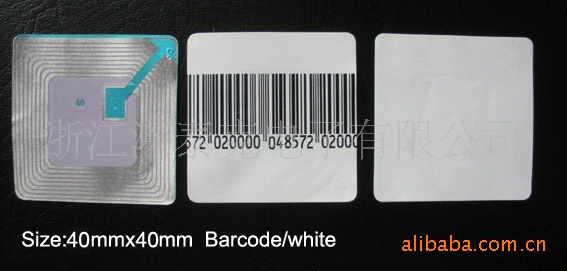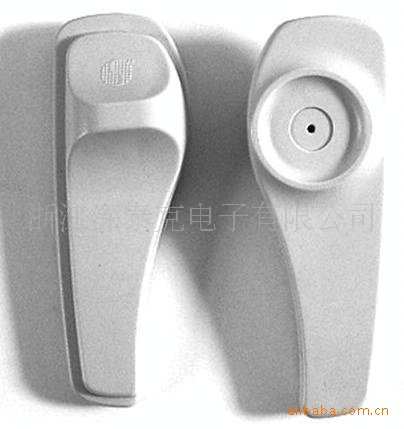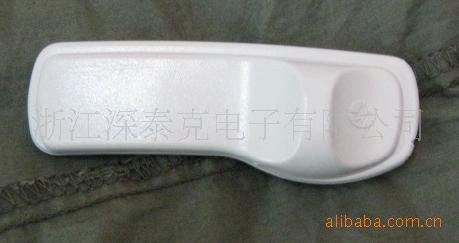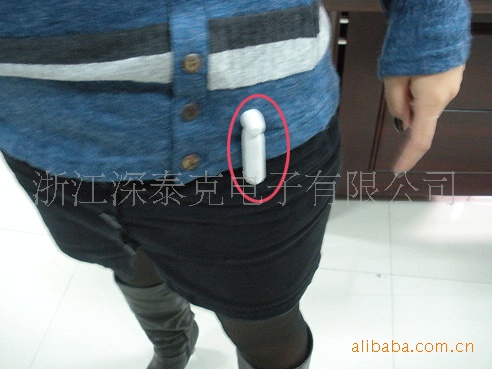
编号: T-031 (小铅笔标签)
频率: 58KHz/66KHz/8.2MHz
尺寸: 50×19×12mm
颜色: 黑色/灰色/白色或客户
开锁: 普通/超强
包装: 1,000只/箱, 0.02立方, 10.5公斤(毛重)
描述: 内含铜丝线圈的轻型标签,适用于精细纺织品,内衣及鞋类商品。
RF射频防盗软标签




AM声磁防盗硬标签 SUPER tag I II


RF射频 AM声磁防盗硬标签 MINI Pencil 小铅笔


An Overview of theTechnologies
What is EAS?(什么是EAS)
Electronic Article Surveillance (EAS) is an anti-theft system that protects merchandise from illicit removal from a retail establishment. An EAS system has three basic components:1) tags-electronic sensors that are attached to merchandise; 2) deactivators and detachers-used to remove or inactivate the tags; and 3) systems that detect the tags at store exits.
电子商品监控(EAS)是一种防盗系统保护零售商的商品免除被偷盗,一套EAS系统包涵三个部分:1)标签,附属在商品上,2)解码器(取钉器),使标签失效3)系统,出口处检测标签
The EAS process begins by attaching tags to merchandise. When an item is purchased, the tag is removed or deactivated. If merchandise with an active label or hard tag is carried past the detection system, the system alarm sounds.
EAS工作开始于商品上的标签,当一个产品被卖掉时标签会被移除(硬标签,如衣服上的标签)或者被解码(软标签,外观像条形码),如果标签未被带移除或者解码,通过门禁系统是,系统就会发出报警声。(可以参考大润发或者沃尔玛的防盗系统)
How EAS Systems Work(EAS系统怎么工作)
EAS systems operate from a simple principle regardless of the manufacturer or the specific type of technology used: a transmitter sends a magnetic or radio frequency signal at defined frequencies to a receiver. This creates the system detection zone. Upon entering the zone, an EAS tag creates a disturbance, which is detected by the system receiver.
EAS系统工作原理很简单不受厂家和产品的形状的影响:一个发射器发射一个定义的无线电信号段(例如我们的产品频率是8.2MHz)给接收器,创建一个系统的检测范围,一旦进入这个区域的标签打乱了这个范围,系统就会报警。
By design the disturbed signal created by the tag and detected by the receiver is distinctive and not likely to be created by natural circumstances. The tag is the key element, for it must create a unique signal to avoid false alarms. The disturbance caused by the tag creates an alarm that may indicate a shoplifting event.
EAS systems range from very low magnetic frequencies through the radio frequency range. These different frequencies play a key role in establishing the features that affect operation.
由设计接收器创造由标签和查出的被干扰的信号是特别和不可能由自然情况创造。标签是关键元素,为了它必须创造一个独特的信号避免假警报。当系统发出报警时表示产品有被盗的迹象。
How Acousto-Magnetic (AM) Technology Works(AM电磁波工作原理)
Acousto-Magnetic systems transmit a magnetic frequency signal at 58 kHz in a pulsed pattern. The transmit signal energizes an acousto-magnetic tag in the detection zone. When the transmit signal pulse ends, the tag responds, emitting a single very distinctive frequency signal. The tag signal is at the same frequency as the transmitter signal.
Acousto-Magnetic系统传送一个磁性频率信号在一个脉冲的样式的58 kHz。传送信号在侦查区域发现一个acousto-magnetic标签。当传送信号脉冲末端,标签反应,散发一个唯一非常特别频率信号。标签信号与发射机信号相同。
While the transmitter is off between pulses, a narrow band receiver detects the tag signal. A microcomputer checks the tag signal detected by the receiver to ensure it is at the right frequency and defined characteristics, occurs at a precise point in time synchronized to the transmitter, at the proper level, and at the correct repetition rate. If all of these criteria are met several times in a row, an alarm occurs. This unique tag signature and the large tag signal produce the Acousto-Magnetic technology's wide surveillance coverage, high tag detection rate, and immunity to false alarms.
当发射机在脉冲之间时,一台窄频带接收器查出标签信号。微型计算机检查接收器查出的标签信号保证它以正确的频率,并且被定义的特征,发生在精确此刻同步对发射机,在适当的水平和以正确重复率。如果所有这些标准连续符合多次,警报发生。这个独特的标记署名和大标记信号导致Acousto-Magnetic技术的宽监视覆盖面、高标记侦查率和免疫对假警报。
How Electromagnetic Technology Works(声磁工作原理)
The electromagnetic system (EM) creates a low frequency electromagnetic field. The field continuously varies in strength and polarity, repeating a cycle from positive to negative and back to positive again.
电磁式系统(EM)创造一个低频率电磁场。领域在力量和极性连续地变化,再重复从正面的一个周期到阴性和回到正面
In response to the changing magnetic field created by the transmitter, the magnetic field of the tag material abruptly "switches" as the field strength varies past a particular point, whether positive or negative. This abrupt change in the tag material generates a momentary signal that is similar to the systems fundamental frequency. Using electronic signal processing techniques, the system identifies the harmonics and causes an alarm.
以回应发射机创造的改变磁场,标签材料的磁场“突然交换”,当场强变化通过特殊点,是否正面或阴性。在标签材料的这急剧变化引起类似系统基频的一个短暂信号。使用电子信号处理技术,系统辨认泛音并且导致警报。
How Swept-RF Works(射频系统工作原理)
Swept-RF uses a transmitter to create a detection zone where tags are detected. The transmitter sends a signal that varies between 7.4 and 8.8 MHz (millions of cycles per second), which is why it is called swept; it sweeps over a range of frequencies.
射频系统使用使用一台发射机创造查出标记的侦查区域,以便能检测到标签。发射器发送一个信号,频率在7.4~8.8Mhz之间(成千上万之间转每秒)。
The transmitter signal energizes the swept-RF tag, which is composed of a circuit containing a capacitor and a coil, both of which store electrical energy. When connected together in a loop, the components can pass energy back and forth or "resonate."
发射器信号使标签能起作用,标签由电容和线圈组成,都能存放电能,当一起连接在圈,组分可能反复通过能量或“共鸣”。
The tag responds by emitting a signal that is detected by a wideband receiver, meaning a receiver that monitors for signals over a wide frequency range; for swept-rf systems the bandwidth is typically about 1,400,000 Hz. By detecting a phase difference between these two signals, the receiver recognizes the presence of a tag, and it alarms.
标签通过散发一台多种频率的接收器查出的信号反应,意味那的接收器为在一个宽频率范围的信号监测;对于射频rf系统带宽是典型地大约1,400,000 Hz。通过查出这两个信号之间的相位差,接收器认可标记的出现,并且发出报警





